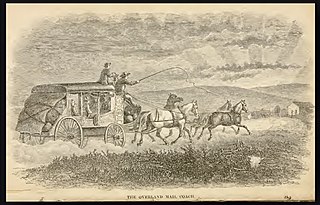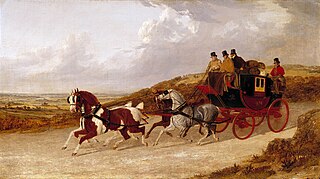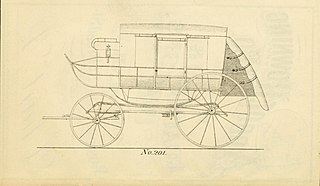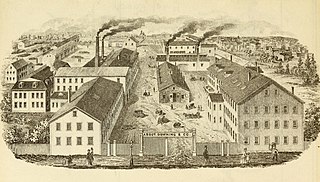
"Riding shotgun" was a phrase used to describe the bodyguard who rides alongside a stagecoach driver, typically armed with a break-action shotgun, called a coach gun, to ward off bandits or hostile Native Americans. In modern use, it refers to the practice of sitting alongside the driver in a moving vehicle. The coining of this phrase dates to 1905 at the latest.

A stagecoach is a four-wheeled public transport coach used to carry paying passengers and light packages on journeys long enough to need a change of horses. It is strongly sprung and generally drawn by four horses although some versions are drawn by six horses.

Cobb & Co was the name used by many successful sometimes quite independent Australian coaching businesses. The first was established in 1853 by American Freeman Cobb and his partners. The name Cobb & Co grew to great prominence in the late 19th century, when it was carried by many stagecoaches carrying passengers and mail to various Australian goldfields, and later to many regional and remote areas of the Australian outback. The same name was used in New Zealand and Freeman Cobb used it in South Africa.
There are many types of car body styles. They vary depending on intended use, market position, location, and the era they were made in.

Butterfield Overland Mail was a stagecoach service in the United States operating from 1858 to 1861. It carried passengers and U.S. Mail from two eastern termini, Memphis, Tennessee, and St. Louis, Missouri, to San Francisco, California. The routes from each eastern terminus met at Fort Smith, Arkansas, and then continued through Indian Territory (Oklahoma), Texas, New Mexico, Arizona, Mexico, and California ending in San Francisco. On March 3, 1857, Congress authorized the U.S. postmaster general, at that time Aaron V. Brown, to contract for delivery of the U.S. mail from St. Louis to San Francisco. Prior to this, U.S. Mail bound for the Far West had been delivered by the San Antonio and San Diego Mail Line since June 1857.

A horse-drawn vehicle is a piece of equipment pulled by one or more horses. These vehicles typically have two or four wheels and were used to carry passengers or a load. They were once common worldwide, but they have mostly been replaced by automobiles and other forms of self-propelled transport but are still in use today.

A mail coach is a stagecoach that is used to deliver mail. In Great Britain, Ireland, and Australia, they were built to a General Post Office-approved design operated by an independent contractor to carry long-distance mail for the Post Office. Mail was held in a box at the rear where the only Royal Mail employee, an armed guard, stood. Passengers were taken at a premium fare. There was seating for four passengers inside and more outside with the driver. The guard's seat could not be shared. This distribution system began in Britain in 1784. In Ireland the same service began in 1789, and in Australia it began in 1828.
Cobb & Co is the name of a company that operated a fleet of stagecoaches in Australia in the late 19th century. Cobb & Co themselves did not operate in New Zealand officially but its name was used by many private stage coach operators.

A coach is a large, closed, four-wheeled, passenger-carrying vehicle or carriage usually drawn by two or more horses controlled by a coachman, a postilion, or both. A coach has doors in its sides and a front and a back seat inside. The driver has a raised seat in front of the carriage to allow better vision. It is often called a box, box seat, or coach box. There are many of types of coaches depending on the vehicle's purpose.

John Butterfield was a transportation pioneer in the mid-19th century in the American Northwest and Southwest. He founded many companies, including American Express which is still in operation today. The Butterfield Overland Mail Company was the longest stagecoach line in the world. The line operated from 1858 to 1861 on the Southern Overland Trail and established an important connection between the new state of California and the government and economy of the contiguous eastern states.

An armored vehicle is an armored van or truck used to transport valuables, such as large quantities of money or other valuables, especially for banks or retail companies. The armored car is typically a multifunctional vehicle designed to protect and ensure the wellbeing of the transported contents and guards. Typically customized on a basic van or truck chassis, they feature bullet-resistant glass, armor plating, and reinforced shells and cabs. Armored cars are designed to resist attempts at robbery and hijacking, being able to withstand bullets from most handguns and rifles, as well as extreme degrees of heat, explosives, and collisions.

The Remington Carriage Museum is located in Cardston, Alberta, Canada. Opened in 1993, and the largest of its kind in the world, the Remington Carriage Museum displays more than 240 carriages.

The Overland Trail was a Klondike Gold Rush-era transportation route between Whitehorse, Yukon and Dawson City in Yukon, Canada. It was built in 1902 at a cost of CDN$129,000 after the White Pass and Yukon Route railroad won a contract to deliver mail to the Dawson City gold fields from the Canadian government. The trail consisted of a 330 miles (531 km)-long, 12 feet (4 m) wide graded surface with culverts in some locations. Before its construction, transportation to Dawson City required a steamboat trip on the Yukon River during the brief subarctic summer, or dog sleds after the rivers had frozen.

The Horseshoe Barn and Horseshoe Barn Annex are two exhibit buildings located at Shelburne Museum in Shelburne, Vermont. Both buildings exhibit a variety of horse-drawn vehicles, including carriages, trade wagons, stagecoaches, and sleighs.
The Overland Trail was a stagecoach and wagon trail in the American West during the 19th century. While portions of the route had been used by explorers and trappers since the 1820s, the Overland Trail was most heavily used in the 1860s as a route alternative to the Oregon, California, and Mormon trails through central Wyoming. The Overland Trail was famously used by the Overland Stage Company owned by Ben Holladay to run mail and passengers to Salt Lake City, Utah, via stagecoaches in the early 1860s. Starting from Atchison, Kansas, the trail descended into Colorado before looping back up to southern Wyoming and rejoining the Oregon Trail at Fort Bridger. The stage line operated until 1869 when the completion of the First transcontinental railroad eliminated the need for mail service via stagecoach.

A stage station or relay station, also known as a staging post, a posting station, or a stage stop, is a place where exhausted horses could be replaced by fresh animals, since a long journey was much faster without delays when horses needed rest. Stage is the space between the places known as stations or stops—known to Europeans as posts or relays.

Deadwood Draw is part of the Sidney-Black Hills Trail near Sidney, Nebraska, which provided supplies for gold mining operations in the Black Hills from 1874 to 1881. The draw served as a staging area for freight wagons carrying supplies to the Black Hills and contains ruts caused by the wheels of the freight wagons and the animals that pulled them. The draw is listed on the National Register of Historic Places.

U.S. Route 385 (US 385) is a part of the United States Numbered Highway System that travels from Big Bend National Park in Texas to US 85 in Deadwood, South Dakota. Within the state of Nebraska, the highway is known as the Gold Rush Byway, one of nine scenic byways across the state. The highway follows along the old Sidney-Black Hills trail which played a crucial role during the Black Hills Gold Rush in the late 1870s. It served as the primary route to transport gold and mining gear between Sidney, Nebraska and the Black Hills to the north. Today, the highway enters Nebraska in the southeastern portion of the Nebraska Panhandle on the state line with Colorado northeast of Julesburg and continues in a northerly direction to the South Dakota state line north of Chadron.

Abbot-Downing Company was a coach and carriage builder in Concord, New Hampshire, which became known throughout the United States for its products — in particular the Concord coach.

The Concord coach is a type of horse-drawn coach, often used as stagecoaches, mailcoaches, and hotel coaches. The term was first used for the coaches built by coach-builder J. Stephen Abbot and wheelwright Lewis Downing of the Abbot-Downing Company in Concord, New Hampshire, but later to be sometimes used generically. Like their predecessors, the Concords employed a style of suspension and construction particularly suited to North America's early 19th century roads. Leather thoroughbraces suspend passengers who are in constant motion while the coach is moving. The swaying is accepted by passengers for the shock absorbing action of the leather straps and for the way the special motion eases the coach over very rough patches of roadway. This suspension, which was developed by Philip de Chiese in the 17th century, was long replaced by steel springs in England.
























